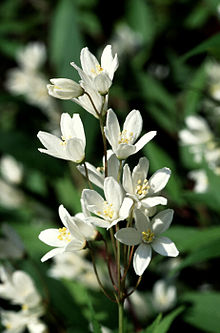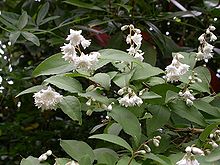- Deutzia
-
Deutzia 
Deutzia gracilis Scientific classification Kingdom: Plantae (unranked): Angiosperms (unranked): Eudicots (unranked): Asterids Order: Cornales Family: Hydrangeaceae Genus: Deutzia Thunb. Species See text
Deutzia (
 /ˈdjuːtsiə/ or /ˈdɔɪtsiə/)[1] is a genus of about 60 species of shrubs in the family Hydrangeaceae, native to eastern and central Asia (from the Himalaya east to Japan and the Philippines), and Central America and also Europe. By far the highest species diversity is in China, where 50 species occur.
/ˈdjuːtsiə/ or /ˈdɔɪtsiə/)[1] is a genus of about 60 species of shrubs in the family Hydrangeaceae, native to eastern and central Asia (from the Himalaya east to Japan and the Philippines), and Central America and also Europe. By far the highest species diversity is in China, where 50 species occur.The species are shrubs ranging from 1–4 m in height. Most are deciduous, but a few subtropical species are evergreen. The leaves are opposite, simple, with a serrated margin. The flowers are produced in panicles or corymbs; they are white in most species, sometimes pink or reddish. The fruit is a dry capsule containing numerous small seeds. Identification of the species is very difficult, requiring often microscopic detail of the leaf hairs and seed capsule structure.
- Selected species
- Deutzia albida
- Deutzia aspera
- Deutzia baroniana
- Deutzia bhutanensis
- Deutzia bomiensis
- Deutzia breviloba
- Deutzia calycosa
- Deutzia cinerascens
- Deutzia compacta
- Deutzia coreana
- Deutzia coriacea
- Deutzia corymbosa
- Deutzia crassidentata
- Deutzia crassifolia
- Deutzia crenata - Crenate Deutzia
- Deutzia cymuligera
- Deutzia discolor
- Deutzia esquirolii
- Deutzia faberi
- Deutzia glabrata
- Deutzia glauca
- Deutzia glaucophylla
- Deutzia globosa
- Deutzia glomeruliflora
- Deutzia gracilis - Slender Deutzia
- Deutzia grandiflora
- Deutzia heterophylla
- Deutzia hookeriana
- Deutzia hypoglauca
- Deutzia longifolia
- Deutzia maximowicziana
- Deutzia mollis
- Deutzia monbeigii
- Deutzia muliensis
- Deutzia multiradiata
- Deutzia nanchuanensis
- Deutzia ningpoensis
- Deutzia obtusilobata
- Deutzia parviflora - Mongolian Deutzia
- Deutzia pilosa
- Deutzia pulchra
- Deutzia purpurascens
- Deutzia reflexa
- Deutzia rehderiana
- Deutzia rubens
- Deutzia scabra - Fuzzy Deutzia
- Deutzia schneideriana
- Deutzia setchuenensis
- Deutzia silvestrii
- Deutzia squamosa
- Deutzia staminea
- Deutzia subulata
- Deutzia taibaiensis
- Deutzia taiwanensis
- Deutzia taiwanensis
- Deutzia wardiana
- Deutzia yunnanensis
- Deutzia zhongdianensis
Cultivation and uses
The deutzias are fairly new to gardens: the exception, D. scabra, was noticed in Japanese gardens by Engelbert Kaempfer (1712) and Carl Peter Thunberg (1784) but not actually seen in Europe till the 1830s; two-thirds of the species noted in the R.H.S. Dictionary were gathered in from the wild during the 20th century.[2]
Deutzias are commonly grown as ornamental plants for their white flowers. Many cultivars and hybrids have been selected for garden use, including selections with double flowers. For example, Deutzia x lemoinei is a hybrid of D. gracilis and D. parviflora.
The temperate deutzias are mostly bone-hardy shrubs, from Far Eastern regions where winters are dependably frozen; in milder climates, like much of England, the early-flowering species and hybrids are coaxed into premature bloom by mild spells, then spoilt by frost. Alice Coats[3] remarks that deutzias done better in Edinburgh, on the chilly east coast of Scotland than they do in London. A solution in milder climates might be to site deutzia in the garden's most exposed, coldest microclimate, as is often done with early-flowering magnolias. Identification can be difficult, and in particular, many of the plants in cultivation sold as D. scabra are actually D. crenata (Huxley 1992). The selected hybrid white double "Pride-of-Rochester", already in cultivation in 1881, was originated y the Rochester, New York nurserymen Ellwanger and Barry.[4]
References
- Flora of China: Deutzia
- Flora of Pakistan: Deutzia
- Flora of Nepal checklist: Deutzia
- Huxley, Anthony (ed.) (1992). New RHS Dictionary of Gardening. London: Macmillan Press. ISBN 0-333-47494-5.
Categories:- Hydrangeaceae
- Asterid stubs
Wikimedia Foundation. 2010.


